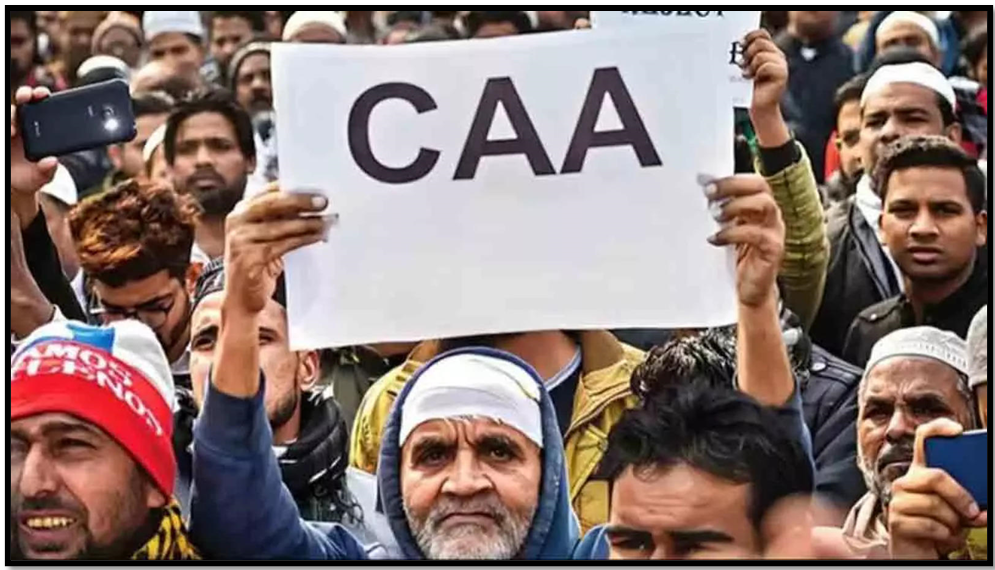MUSLIM EXCLUSION AND THE LENS OF THE
Syllabus:
GS 2:
- Constitution of India —historical underpinnings, evolution, features, amendments, significant provisions and basic structure.
Focus:
- Recently, the Indian government notified the rules for the Citizenship Amendment Act (CAA), 2019
Source:- Zeebussiness
Introduction to the CAA 2019
- The Citizenship (Amendment) Act (CAA), 2019, excludes Muslims from Pakistan, Afghanistan, and Bangladesh from acquiring Indian citizenship.
- Union Home Minister Amit Shah cited the Partition and the Islamic state status of these countries as reasons for the exclusion.
- The CAA aims to provide citizenship to persecuted minorities from these countries, implicitly excluding Muslims due to their majority status there.
| CAA 2019
· Citizenship in India: It refers to the legal status and relationship between an individual and the state, entailing specific rights and duties. · Legislative Authority: The Constitution of India vests the authority to regulate citizenship exclusively with the Parliament, as listed in the Union List. · Citizenship Act, 1955: Enacted by Parliament, it outlines five methods of acquiring Indian citizenship: by birth, descent, registration, naturalization, and through incorporation of territory. · Amendment in 2019: The Citizenship Amendment Act (CAA), 2019, amended the Citizenship Act, 1955, to grant citizenship to persecuted migrants from Hindu, Sikh, Buddhist, Jain, Parsi, or Christian communities from Pakistan, Bangladesh, and Afghanistan. · Eligibility Criteria: Migrants entering India on or before December 31, 2014, due to religious persecution in their home countries are eligible for accelerated citizenship under the CAA. · Exemptions: The CAA excludes regions under the Sixth Schedule of the Indian Constitution and areas covered by the Inner Line Permit system, safeguarding the interests of tribal and indigenous communities. · Relaxations: The CAA relaxes the residency requirement for citizenship by naturalization from 11 years to 6 years for migrants belonging to the specified religions and countries. · Purpose: The amendment aims to provide expedited citizenship to persecuted religious minorities from neighboring countries, offering them protection and a pathway to Indian citizenship. |
Partition and Historical Context
- The argument that Partition was solely a Muslim elite-driven project overlooks the complex historical and socio-political factors.
- Influences such as the Hindu right’s vision of a Hindu Rashtra and British colonial divide and rule policies played significant roles.
- Notably, a significant portion of Indian Muslims opposed Partition, with leaders like Maulana Abul Kalam Azad and Sheikh Abdullah advocating for a united India.
- The liberation of Bangladesh in 1971, led by Bangabandhu Mujibur Rahman, contradicted the two-nation theory, emphasizing secular leadership among Muslims.
Misconceptions and Generalizations Post-Partition
- The broad-blaming of Muslims for Partition overlooks the diversity of opinions and resistance among Muslims against the division.
- Figures like Ayesha Jalal highlight that Partition was a partial and not a definitive solution to the minority issue in the subcontinent.
- The aftermath of Partition saw confusion and reconsideration among Muslims, many of whom opted to stay in India, contributing to its development and diversity.
The Argument of Persecution
- The CAA’s framing suggests that Muslims cannot be persecuted in Islamic states, ignoring intra-Muslim sectarian violence and discrimination.
- Sects like Ahmadis and Shias in Pakistan face significant persecution, challenging the narrative that Islamic states uniformly protect all Muslims.
- Historical examples, such as the treatment of Nobel laureate Abdus Salam due to his Ahmadi faith, illustrate the complexities of religious persecution in these countries.
Broader Context of Right-Wing Politics
- The exclusion of Muslims in the CAA is part of a larger right-wing ideological project aiming towards a de-Islamization of India.
- This includes political strategies like not fielding Muslim candidates, targeting Islamic educational and religious institutions, and questioning the legal status of mosques and shrines.
- The broader agenda reflects a systemic attempt to marginalize Muslim identity and influence in India, raising concerns about secularism and democratic inclusivity.
Conclusion and Reflection
- The CAA 2019 and the discourse surrounding Muslim exclusion reflect deep-seated historical, political, and ideological tensions in India.
- The simplistic attribution of Partition to Muslim communities disregards the nuanced realities of historical events and their contemporary implications.
- The challenge lies in addressing these complexities in a manner that upholds India’s secular and democratic ideals, ensuring equity and justice for all communities.
|
Source:
Mains Practice Question:
Analyze the impact of the Citizenship (Amendment) Act, 2019 (CAA) on India’s secular fabric and its relations with neighboring countries. Discuss the historical context provided by the Partition of 1947 and its influence on the CAA. Additionally, evaluate the role of internal politics and ideological shifts in shaping the narrative around Muslim exclusion.




